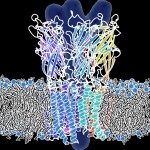Lien vers Pubmed [PMID] – 19995852
Lien vers HAL – Cliquez ici
Lien DOI – 10.1113/jphysiol.2009.183160
J. Physiol. (Lond.) 2010 Feb;588(Pt 4):565-72
Pentameric ligand-gated ion channels (pLGICs) are widely expressed in the animal kingdom and are key players of neurotransmission by acetylcholine (ACh), gamma-amminobutyric acid (GABA), glycine and serotonin. It is now established that this family has a prokaryotic origin, since more than 20 homologues have been discovered in bacteria. In particular, the GLIC homologue displays a ligand-gated ion channel function and is activated by protons. The prokaryotic origin of these membrane proteins facilitated the X-ray structural resolution of the first members of this family. ELIC was solved at 3.3 A in a closed-pore conformation, and GLIC at up to 2.9 A in an apparently open-pore conformation. These data reveal many structural features, notably the architecture of the pore, including its gate and its selectivity filter, and the interactions between the protein and lipids. In addition, comparison of the structures of GLIC and ELIC hints at a mechanism of channel opening, which consists of both a quaternary twist and a tertiary deformation. This mechanism couples opening-closing motions of the channel with a global reorganization of the protein, including the subunit interface that holds the neurotransmitter binding sites in eukaryotic pLGICs.




